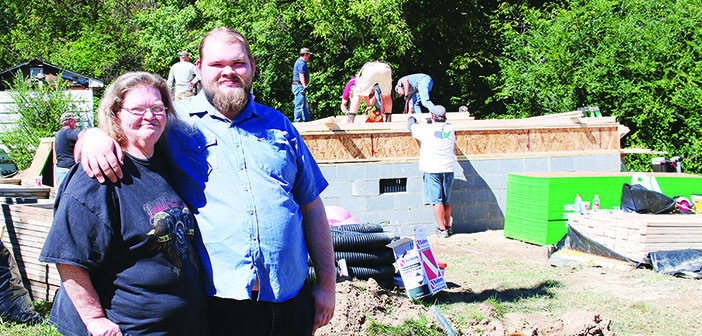
Gene Gorab, here working on the Hiser house, has been instrumental in the New Build program’s growth. Photos by Sarah Colson
By Jeff Keeling
The sounds of hammers ringing, circular saws whining and boots tromping on freshly laid subflooring punctuated the still, misty morning air on a dead-end block of Park Avenue in east Johnson City Monday morning.
By late afternoon, long after the mist had burned off and been replaced by brilliant blue October skies, the sound of power and manual tools was continuing, as it had unabated for most of the day. And it was music to Kim and Tearston Hiser’s ears.
The sounds were generated by a large crew of volunteers from a church in Connecticut, who were framing a new, 864-square-foot, three-bedroom house for Kim and her 18-year-old son through Appalachia Service Project’s “New Build” initiative.
“I’m just tickled,” said Kim as the volunteers prepared to raise the first wall and the sun bore down on the Park Avenue block filled with small, humble-looking dwellings. “I’m so happy.”

Leigh Leach, left, and Will Crumley review house plans prior to the beginning of framing work Monday.
She wasn’t the only one. So was Gene Gorab, an ASP board member leading a crew from Fairfield, Conn., including members of his church, Greenfield Hill Congregational, in hopes of completing framing by today. Gorab, who manages a private equity fund, started volunteering for ASP nearly a decade ago. He took all three of his daughters to sites in rural Appalachia to help with home repairs. Then, after Washington County’s Dry Creek floods in 2012, Gorab donated time and money in what became a new model for ASP – building new homes instead of trying to repair ones that would remain substandard even after those efforts.
“I’d indicated a willingness to be more involved, and after Dry Creek, Walter Crouch (ASP CEO) and (Washington County Mayor) Dan Eldridge reached out to me,” Gorab said.
“We had a single site with a lot of need, so you could mobilize a lot of forces and make an impact more quickly.”
Seeing how dozens of new homes were built in Dry Creek, usually with cash resources of less than $20,000, sparked an idea in Crouch’s mind: look toward replacing, not repairing, some of the substandard houses that represent a chronic problem throughout Kentucky, West Virginia, Southwest Virginia and East Tennessee.
With the help of several grants, that endeavor has spread.
Backing money comes from the Federal Home Loan Bank of Cincinnati and the Appalachian Regional Commission, but replicating the program in West Virginia and Virginia would require a different funding source. With Tennessee’s First District Congressman Phil Roe as an ally, Crouch, Gorab and others are turning over stones in Washington. Language in some HUD-based funding programs could be amended to make eligible what Gorab calls a rare opportunity for efficient use of government funds.
“Sometimes there’s a point at which we’re not doing our clients a service by just continuing to improve something that should be torn down,” Gorab said. “To the extent we have the weaponry to eliminate substandard housing in a more efficient, economic way with a more permanent solution to the housing issue, why wouldn’t we?”
He said the reception in Congress from multiple representatives has been very positive. With volunteers
building the houses, “once people see how far a project dollar can go, I think it’s pretty magical.”
It certainly felt magical to Hiser and her son, who said upon learning they’d get a new home to replace the tiny one he’d lived in his whole life, “I was shocked an excited at the same time. I was like, ‘oh, my.’”
Kim Hiser said a case manager first told her about the ASP program early this year while visiting the now-demolished house where, Hiser said, “Tearston would walk through and the floors and stuff would give.” Things moved quickly from there, with Johnson City’s community development department providing the matching funds from its Community Development Block Grant program.
“I just thanked the Lord that it come about, because I had no money and the house was falling in around me,” said Hiser, who is disabled.
Gorab said he’s optimistic the New Build initiative will come into more funding streams, whether from HUD, the Federal Home Loan Banks in Richmond and Atlanta, or both.
“Because this started as a mission, people that get involved either financially or through personal labor, it’s from their heart. Because we can take that and combine it with a good use, which is rare in government funds, I think you’re on to something.”
If more help comes, there are plenty of Kim Hisers throughout Appalachia waiting on a little magic.







